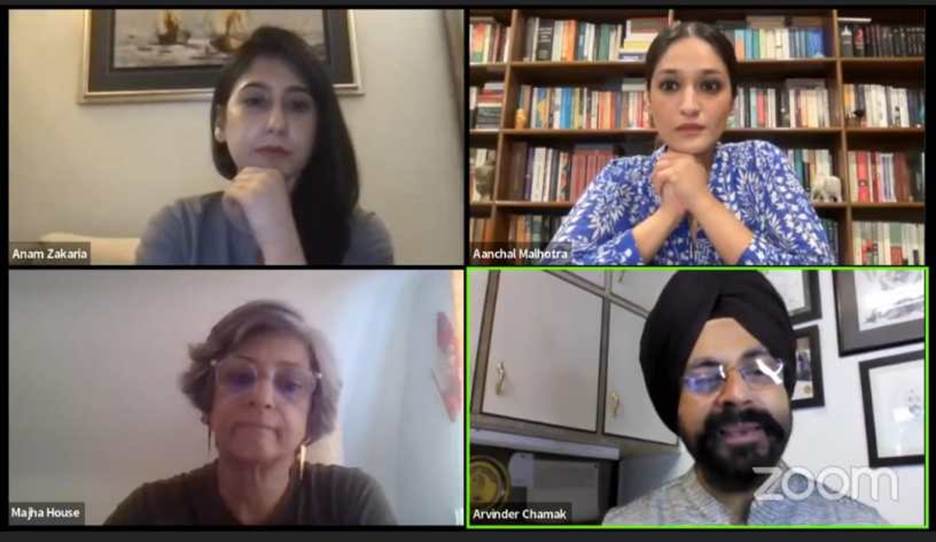
Authors, historians and educationists from both sides of the India-Pakistan border shared memories and notes at a recent online discussion ‘Footprints of Partition’. It was part of the Sanjha Punjab series organized by Majha House in Amritsar
Cross-Border Narratives
By Sara Arshad
Lahore, Pakistan
Oral historians who step into fractious volatile spaces “bring us a lot” in terms of layered information and nuance, comments freelance editor and publishing consultant Preeti Gill.
She was speaking at an online panel discussion , Footprints of Partition, on the 76th Independence Day of India and Pakistan, held as part of the Sanjha Punjab (Unified Punjab) series, which she curates.
Sanjha Punjab is an offshoot of Majha House , Preeti Gill’s family home in Amritsar that she converted into a cultural center in 2018. The place has since served as a kind of ‘salon’ for India’s top writers and intellectuals, participating in regular discussions and events. Majha House has held close to 100 such sessions so far.
When the Covid-19 pandemic shut everything down, poet and peace activist Dr Arvinder Chamak who is on the Majha House Board of Advisors started Sanjha Punjab, an online discussion series focusing on the common interests of the two Punjabs across the border in India and Pakistan. This opened up the discussions to a wider audience.
Sanjha Punjab provides a space for artists and writers from both sides of the border to come together virtually to share stories, culture, language, history, music, poetry, and food.
United by history and poetry
Although we live on different sides of a hostile border, I consider Dr Chamak a mentor. He has managed to obtain visas to visit Lahore, where I live, several times. We share a love for the iconic poet Faiz Ahmed Faiz whose words continue to resonate with people on both sides of the border and beyond.
Dr Chamak moderated the discussion in August with young writers and historians Anam Zakaria and Aanchal Malhotra . Both panelists have delved into family histories shared by their mothers, grandmothers, and community members and meticulously compiled these stories in their writings and books.
This was the second time I heard them speak together. Some months ago, they were part of another panel with historian Ananya Jahanara Kabir , organised by the Southasia Peace Action Network or Sapan. Sapan has much in common with Majha House and its mission. Both hold regular discussions on various issues bringing people together and bridging divides.
Partition and politics
The Sanjha Punjab panel discussion took its title from Anam Zakaria’s book Footprints of Partition , a narrative of four generations since 1947, for which she spoke to the extended families of Partition survivors. Their descriptions help us to better understand their insights into the period and the horror suffered by victims.
Policymakers have made the situation worse over the years with their stringent visa policies and extreme political views.
Both panelists spoke not only about the barbarity but also about deep-rooted friendship and love between people on both sides — stories of survival, empathy, and tolerance, how friends saved each other’s families, and how people of one religion helped others to migrate or escape.
Most young people don’t have easy access to such personal narratives and find it easy to believe nationalist narratives based on hate.
“People can’t fit into those neat binaries the way the state wants to project them. The violence and bloodshed stories coexisted with softer stories like rescuing friendship along with romantic stories,” says Aanchal Malhotra.
Dr Chamak shared his tragedy about how his Nana (maternal grandfather), a physician from Gujranwala on the Pakistan side of Punjab, was killed in front of his wife (Dr Chamak’s grandmother) near the Wagah border. To this day, Dr Chamak is reminded of this tragic incident when he looks out of his office window in Amritsar.
“If Pakistan could open the Kartarpur visa-free corridor, why can’t the no-man’s land between the borders open up and let people on both sides meet without a visa,” he asked. “Let there be peace, love, and harmony. If the Berlin Wall can come down, why can’t India and Pakistan do this?”
From bitterness to understanding
Eminent educationist Jasmeet Nayyar delivered the closing remarks. A former director of higher education in Punjab, she has also served as principal of a women’s college in Amritsar. She talked about her experience working with the Pakistani diaspora when the Indian Government of India deputed her to Iran and Nigeria.
While exchanging stories of Partition, there was initially some bitterness, which developed into a sense of understanding with more conversations. She said it is essential for the new generation to listen to these oral historians to reduce the bitterness between the two nations.
In closing, she recited the following lines written by Indian poet Rahi Masoom Raza to reflect on human connections:
‘Wo jin sey ham choot gai ab woh jahan kaissey hain?
Woh makeen kaissey hain?
Sheeshey kai makaan kaissey hain?
Aey bad-e-saba tu tau udhar sey bhi guzerti ho gi
Hawa nai tu chalna hai, saba nai tu chalna hai
Aey bad-e-saba tu tau udhar sey bhi guzerti ho gi
Uss gali mai mere pairon kai nishaan kaissey hain
Those who are separated from us, where and how are they?
Those occupants, how are they?
How are those glass houses?
Oh cool breeze, you must pass from there too
The wind will blow, the breeze will flow
Oh cool breeze, you must pass from there too
What are my footprints like in that street?
(Sara Arshad is a teacher and writer based in Lahore. This is a Sapan News syndicated feature.)

